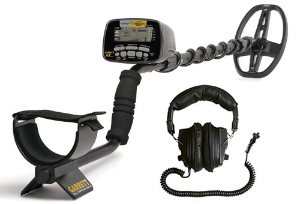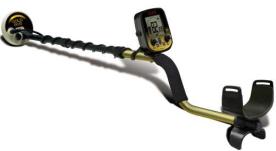Tuesday, February 14 2023
There are a variety of searchcoil sizes and shapes and configurations. The correct one to use depends on the environment it will be CONFIGURATIONS Concentric Mono Imaging DD Search coils have two smaller “D” shaped coils housed inside to penetrate heavily mineralized ground that is commonly encountered while gold prospecting and relic hunting. The Double-D configuration is designed to
Monday, February 13 2023
The searchcoil is a vital part of your metal detector. It generates a magnetic field and senses metallic targets in the surrounding environment. The size and depth of the magnetic field is determined by the shape and size of the searchcoil. Understanding the purposes behind the various sizes and shapes of searchcoils will empower you with the ability to choose the best coil for each application. HOW SEARCHCOILS WORK SEARCHCOIL DEPTH SEARCHCOIL SIZES
Garrett is the global leader of ground search metal detectors, pinpointers, coils, and other accessories. Browse Garrett detectors and more. Wednesday, February 08 2023
Grab your Garrett metal detector and accessories and head to Canton, Texas, April 14-16 for their Memorial Hunt! Ti Details: Friday, April 14, through Sunday, April 16 in conjunction with Texas Association of Metal Detecting Clubs (TAMDC). The event will be held at: First Monday (flea market grounds) 800 First Monday Lane Canton, TX 75103 Basic Hunt Package:
Plenty of Fun for All Ages!
Whether it's time to buy your first Garrett metal detector, an upgraded model, or additional coils, headphones, carry bag or other accessories, check out the selection of Garrett treasure hunting items here. Thursday, April 28 2022
Over the years, metal detecting has continued to become one of the most popular forms of gold prospecting, especially with folks new to prospecting. Panning, sluicing, and highbanking can be lucrative ways to recover the shiny stuff, but when you’re first bitten by the gold bug, you might opt for the simplest, quickest approach — swinging a detector. Not only is it physically easier than processing heavy dirt and rock, it offers the added bonus of finding more than just gold, such as coins, jewelry, relics, and other buried metallic treasures, too. Aside from record gold prices, another reason that people are eager to try metal detecting i The basic premise of metal detecting is allowing the detector to introduce an energy field into the ground, and allowing that field the opportunity to return any target information that it finds via the detector’s control box. The two most common types of metal detectors to consider: VLF (very low frequency) metal detectors are the most common type of detector. They work by sending out energy that is either reflected off or conducts through an object containing metal. The device then measures how long it takes for the signal to return. Frequency refers to how fast a metal detector sends signals into the ground. As the name indicates, these detectors use very low frequency coils (generally below 30 kHz.) The outer coil serves as the transmitter and the inner coil serves as a receiver. PI (pulse induction) metal detectors send energy into the ground and measure the decay of that signal. Anything that slows or speeds the decaying signal is a target. This technology sends powerful, short bursts (pulses) of current through a coil of wire. Each pulse generates a brief magnetic field. When the pulse ends, the magnetic field reverses polarity and collapses very suddenly, resulting in a sharp electrical spike. This spike lasts a few microseconds (millionths of a second) and causes another current to run through the coil. This current is called the reflected pulse and is extremely short, lasting only about 30 microseconds. Another pulse is then sent and the process repeats. Generally speaking, the higher the price of a metal detector, the more features it will have. More features translate into more knobs. The more features and/or knobs that a detector has, the more you are able to tune the metal detector to the type of hunting conditions that you are likely to encounter. With that being said, the downside to a large number of features is that even though you are able to fine tune the detector to match the local conditions, there are also more ways of setting up the detector incorrectly. Setting up a machine "wrong" may result in a decrease in depth and sensitivity and your $900 metal detector may be outdone by a $200 model! It is critical to read the owner’s manual that comes with your detector and learn to use it properly for maximum results. Keep in mind when shopping for a detector that gold detectors are not necessarily higher in cost, but they are built with a higher sensitivity to detecting gold nuggets, have better ground balancing and discrimination abilities, and could be the best option for you. The #1 question that everyone asks is “What is the best metal detector?” Unfortunately, there is no one single answer. Each metal detectorist has specific needs that cannot be met by one single detector. The easiest way to find the "best" detector is to evaluate YOUR detecting style, your experience level, what items you hope to find, and the time that you will spend metal detecting. After taking all of these things into consideration, then you will be able to find a metal detector that fits your needs and your budget. If you’re wondering how deep a detector can detect, realize that there are too many variables to be able to unequivocally quote a depth for any particular brand or model. The size of the target, how it is positioned, ground mineralization, ground moisture, and more are just some of the factors that affect the depth of a detector. When treasure hunting with your detector for coins, relics, or jewelry, use your imagination as to where to hunt — anywhere people are likely to have lost something or left something behind is a likely place to dig up good finds—playgrounds at schools and parks, picnic areas, campgrounds, new construction sites, ghost towns, old homesteads, woodlands, plowed fields and pastures, sports fields, showgrounds, and racetracks, swimming holes, beaches, jetties, and piers. Right under your feet might be a good place to start; you never know what you'll find in your own backyard! Remember to always know local laws before using your metal detector. Many state and national parks and historic sites do not permit detecting. Be sure to first ask permission to treasure hunt on private property. If you want to get out there this year and get your share of the gold but the idea of panning, sluicing, highbanking, or using another piece of gold mining equipment just isn't your idea of fun, that's OK. Consider a metal detector instead. Since the lure of uncovering a gold nugget of any size is addictive, you'll see people in known gold bearing areas swinging a detector, listening intently through their headphones for that magic tone that says DIG. Go ahead and join the fun! Today it is easier and more productive than ever to go treasure hunting. The metal detecting hobby has gone to a whole new level using state of the art technology that makes metal detecting equipment more high tech than ever. Monday, March 15 2021
Spring is in the air, and Garrett is making it a little easier on your wallet to get out there and start swinging a new metal detector! For a limited time, Garrett is offering two specially-priced packages. Each package includes a metal detector, headphones, an AT Pinpointer, and Garrett Edge Digger. You save $134.90 on a package as compared to buying each component separately. Both packages have FREE SHIPPING, too! Garrett AT Pro Metal Detector and Headphones. The AT Pro is Garrett's all-terrain, all-treasure, deep-seeking, professional treasure hunter's detector! This all-terrain detector offers new and exclusive Garrett technology that makes highly recommended for Coin Hunting, Jewelry Hunting, Relic Hunting, Cache Hunting, Prospecting, Ghost Town Hunting, Competition Events, Beach/Fresh Water Hunting. Select from either Standard or Professional search modes with enhanced audio features. The AT Pro was designed to work in challenging environments such as mineralized ground, high trash areas, wet and humid areas and dust. In fact, the entire metal detector can be submerged under water to a dept of 10 feet, so it's an excellent choice for detectorists who might also be gold prospectors working in streams, ponds, or shallow water off the shoreline. Includes upgraded MS-2 headphones, Pro-Pointer AT Pinpointer and Garrett Edge Digger. Details on AT Pro Spring 2021 package here. Garrett ACE 400 Metal Detector and Headphones. The top of the ACE family, the 400 has a new Iron Audio feature, a powerful DD coil, a higher frequency, and volume control headphones. Its advanced features make the ACE 400 powerful on coins, jewelry, and artifacts. Features a 8.5” x 11” PROformance DD submersible searchcoil. Comes with Pro-Pointer AT Pinpointer, Garrett Edge Digger, and ClearSound Easy Stow Headphones that feature padded ear pieces, 41 inch coiled cord extends to 82 inches, and 1/4 inch phone plug. Details on ACE 400 Spring 2021 package here. Metal Detectorist Code of Ethics
Sunday, December 20 2020
There is truly no single “best” type of detector when it comes to gold hunting. But understanding the differences between a VLF (very low frequency) and a PI (pulse induction) detector and their coils can help you decide which detector might be the “best” to use in a A VLF machine can have an advantage on shallow and very small targets, on and off of bedrock— as long as you can keep it stabilized, ground balanced, and the sensitivity set properly. PI detectors generally do better at greater depths than VLF machines, especially in highly mineralized soils. Mono coils are designed for PI detectors. There is a single winding inside the coil that puts a concentric pattern into the ground. You will always get more depth with a mono coil, but it is more susceptible to ground mineralization noise and it will be affected by the ground mineralization itself. Double D coils work for both PI and VLF detectors. Double D coils have two back-to-back D shaped windings inside the coil. At all times the coils are transmitting and receiving across the plane of the coil. The Double D design is like a knife blade that goes into the ground down the center of the coil. These coils are great at handling mineralization where it essentially takes the ground mineralization and distributes it all the way across the blade, lessening its effects. Concentric coils work with VLF detectors by using two separate windings inside the coil— one sends and one receives. When it comes to a round versus elliptical coil, there is really no difference in the size, only shape. Coils are measured off of a round coil configuration. For example, a 14 x 10 inch coil will have the same attributes as a 12-inch coil. The key difference is that elliptical shapes work extremely well in difficult areas. Although each metal detector has its pros and cons, you can’t go wrong by wearing the best headphones possible, no matter which brand or model you choose. Many gold nuggets you will find are only slight whispers in the detector’s threshold, so you want to always wear high quality headphones. Plastic scoops and a digging tool with a wide blade should also be in your accessory bag. When hunting, limit the amount of metal on your body, which includes wearing non-magnetic boots and belts. Put your car keys in your back pocket. Keep your cell phone in your back pocket, too, and make sure it’s off to avoid any interference. Tuesday, June 23 2020
Ocean beaches can be compared to the Mother Lode. Why? Because you can find GOLD on many by mining with a highbanker, and by searching with a metal detector. How lucky is that?! TWO ways to find gold at the same location! Think about it, who hasn’t lost a ring or coins at the beach? Whether you prefer recovering gold by swinging a detector or shoveling into a high banker, your chances of both are higher by visiting a beach this summer that is located in a gold-bearing area. A side benefit is that you’re enjoying the nice weather while it lasts while mining the beaches in different ways. Beach Mining with a Highbanker When you consider the advantages of beach mining with a highbanker— easy access in all seasons, no classifying material down to size, no digging in heavy cobbles and moving boulders, no worries about rattlesnakes or poison oak— the idea is very appealing. Of course any new environment means there will be a learning curve. Recovering 100 mesh gold from the beach requires a little extra attention to detail to prevent loss, so you’ll need to readjust your equipment and process. Don’t expect chunky nuggets; you’re going for the flour gold here. High tide, not your watch, will dictate your schedule. The general principles you already know are the same, but also keep these tips in mind. • Slow down. Expect to process about 10 gallons of material an hour. If you try to feed a highbanker faster or use bigger scoops you will likely lose gold. The most efficient way to locate the paying black sand layers is to use a post hole digger or earth auger. The pay layer is usually right on top of a golden brown sand layer that pushes up into the black or blue sand. Frequent storms can remove the light sands and reconcentrate the black sands. • Use about 25% of the water you would normally use. You may need to modify your spray bar to compensate for less water volume so you aren’t fighting foam and bubbles. • The beach is a level playing field—literally, so tip your box to a 9-degree angle and go from there. Most beach miners use battery-powered bilge pumps to run their beach sluices. A small gas-powered pump also will work. A Gold Cube is also an excellent piece of recovery equipment to concentrate beach material, then run it through a Blue Bowl. • Do frequent clean-ups. Beach Mining with a Metal Detector Water and sunscreen have a sneaky way of slipping rings from fingers of swimmers and sunbathers, making beaches a lucrative location for metal detecting. There are actually several similarities between beach hunting for jewelry and hunting for gold in the rivers. At the beach, stuff that is lost in the upper sand areas make their way down into the surf during large storm events just like gold is washed downstream in the same storms. You can find an occasional nugget above a river in gold country, but you’re going to make your best finds when you locate the pay streak where nature has concentrated the gold. The same is true of the beaches. You will find that the surf sorts out materials, and when you are really lucky, you can identify a pay streak. In a river, the gold pay streaks follow the downstream flow of the river, but on the beach the pay streak will typically run horizontal across the beach. After items have been in the sand/surf for some time, the wave and current action tend to sort thing by weight and density. The pull tabs will be in a certain line, the lighter coins further down towards the deeper water, and when you start detecting fishing weights, you are likely nearing a pay streak. That is where you are most likely to strike gold— as in gold rings, bracelets, pendants, etc. Wet sandy areas are particularly lucrative for detectorists. The reason for this is that beach-goers first congregate at the "towel line" and then migrate to wet sand. The "towel line" is an invisible area where the majority of people plop down their towels and coolers and umbrellas. At the towel line, sunbathers slather on slippery sunblock and tanning oil that acts like a lubricant and lessens friction. After baking in the sun for a while, they will need to go into the water to cool off a bit, which is where the body's natural reaction to cold is to shrivel up. Less friction + shrinkage = rings in the wet sand you can find with your metal detector! In all types of beach hunting, the discrimination must be kept very low, eliminating only small iron (bobby pins and nails). Aluminum pull tabs and tin foil should not be discriminated or you will lose some gold and/or platinum rings as well. Some beach hunters operate with zero discrimination and dig everything. Use of a sand scoop makes target recovery fast and easy. It’s important to realize that most gold rings will read in the “middle” tones (above iron but below coins). If you’ve ever hunted the beach you have no doubt found your share of unwanted nails and other litter. To solve this, lace a rare earth magnet in the scoop to quickly capture those small, annoying iron targets. If you’re going to hunt the salt beach areas, you’ll want to get a heavy duty plastic scoop. A steel scoop will rust fairly quickly in those harsh conditions. If you intend to hunt IN the water, of course you will need a waterproof metal detector and waterproof headphones — one that can handle salt water mineralization. There are some good pulse induction machines that work extremely well in salt conditions. Very shallow water is no problem but when you hunt waist deep water and deeper you should consider a mask and snorkel. If possible, hunt at low tide. That way you can get further out and hunt where other detectorists might not have gone. Plus, the surf tends to pull things down the beach and out into deeper water.
Saturday, May 02 2020
Researching new areas in which to prospect for gold, gems, or whatever you are seeking can be a lot of work, but since we’re now
Tuesday, February 11 2020
The big gold rushes of the 19th century have long since ended, but in most cases you can still prospect for the precious metal in these Below is a very short list that offers a few ideas only. Beginners should search the internet or join a local gold prospecting organization for more information.
Keep in mind that even if there has been no major “rush,” major amounts of gold have been found in many other states, too, including Georgia, Michigan, Montana, New Mexico, Oregon, South Carolina, Tennessee, Texas, Utah, Virginia, Washington, Wisconsin, and Wyoming. Good luck! Friday, February 01 2019
Did you know... there is actually more gold still out there waiting to be found today than the old-timers ever
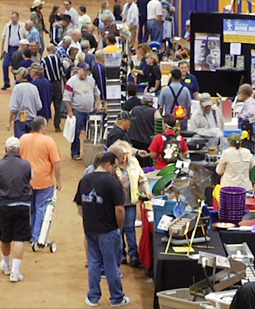 recovered way back in the 1800s gold rush era? And did you also know that attending a GPAA Gold and Treasure Show (Gold Prospector's Association of America) is a great place to get started on your modern day treasure hunt?! recovered way back in the 1800s gold rush era? And did you also know that attending a GPAA Gold and Treasure Show (Gold Prospector's Association of America) is a great place to get started on your modern day treasure hunt?!Browse the show floor to find dozens of leading worldwide manufactures and local vendors demonstrating the latest and greatest gold mining and metal detecting equipment, attend free seminars, ask questions of the pros, and enter to win thousands of dollars in door prizes. Pick up a pan for the first time or hone your skills at the panning zone, where skilled instructors will help you recover gold, for free. Keep all the gold you find!
Saturday show hours 10 am - 5 pm and Sundays 10 am - 4 pm in these cities:
Visit the GPAA website for more details and to buy your $5 adult tickets; kids 12 and under plus military and veterans with ID are FREE. If you can, make a family road trip out of attending one or more of the shows this spring. In addition to the show itself, each city has fun touristy things to do, and if you're a GPAA member, you can visit nearby mining claims.
Whether you’re a family with kids or a lone enthusiast, a GPAA Gold & Treasure Show is your one-stop-shop for all of your gold prospecting and treasure hunting wants and needs. By attending a show, you're sure to have a blast, meet interesting people, find new tools, and learn new tricks of the trade. All of that is enough to make you hollar Eureka!
Nugget of News Blog Monday, August 06 2018
Back to School promo! Limited time only— combo price ends August 18, 2018! Each Teknetics T2 metal detector is now shipping with stereo headphones and a digger recovery tool. ALL FOR $499 with FREE SHIPPING! Buy now using coupon code A1486.
The T2 excels at coins-shooting, relic hunting and gold prospecting.
Digger Recovery Tool:
Back-To-School Combo price ends August 18, 2018! Get the package for only $499 with FREE SHIPPING! Buy now using coupon code A1486. Nugget of News Blog Saturday, April 29 2017
The NEW Ameritek metal detectors have arrived! The Minuteman, Liberator, and Patriot, are three new • Turn-on-and-go, well balanced and lightweight Click here to get it for $199 AND FREE SHIPPING AND FREE ACCESSORY KIT with coupon code A1486 Liberator • V-Break, variable tone breakpoint Click here to get it for $299 AND FREE SHIPPING AND FREE ACCESSORY KIT with coupon code A1486 Patriot • Detects coins to 12 inches Click here to get it for $399 AND FREE SHIPPING AND FREE ACCESSORY KIT with coupon code A1486 Guidelines for All Metal Detectorists Realize that each time you go detecting you will be representing EVERYONE in this sport; all will be judged by your actions. Detectorists are a very visible group and the public knows what you are doing. That is why you must conduct yourself accordingly, learn proper recovery techniques and abide by a code of ethics. Scars from improper or sloppy recovery methods can remain for years and further damage the image of this activity. This can only lead to tougher laws and regulations. Even in remote areas it is very important to always leave no sign you were there. Learn about your local laws regarding metal detecting, especially on Federal, State or County lands, because they can vary significantly from state to state. Make the effort to search the local public records to verify the laws regarding metal detecting in your area BEFORE you go detecting. Do the same with State and Federal agencies that govern lands AND waters in your area. If you will be hunting on private property you MUST obtain permission ahead of time and be absolutely certain you know the exact boundaries of the property or yard. Check with your County land records office (usually County Seat) to obtain information on how to research or obtain land ownership plats. In some places this information is available online or you may be able to purchase a plat book for your County (some libraries also have copies you can view). These plat books are useful tools, showing owner’s name and boundaries, as well as Federal-, State-, and County-owned lands. However, it is your responsibility to still check with the land owner to verify the plat map is correct. Penalties and fines can be very costly. Ignorance of the law is not an excuse. Once you have a name, try to locate the owner’s address and pay him a visit. Introduce yourself, express your interest and ask if he would allow you to metal detect on his property. Explain your practices and how you will proceed. Always be polite, even if he turns down your request. If given permission, find out if there are any limitations he might have; certain times of the day, where to park your vehicle, certain areas that might be off limits, etc. Above all else, you must carefully cultivate the relationship between yourself and the land owner to ensure that you always have his/her best interest in mind. Often there may be others, such as hunters, using their property as well. Crop lands might be leased to a farmer; buildings may be rented or leased to other families. If your activities offend any other users, they will also offend the owner and that will reflect negatively on the sport. You may even get kicked off the property. When you are on private property, your actions and activities must always be beyond reproach. You must always put the owner’s concerns above all else. And this is just as true if you are in a City park or on school grounds. There are numerous cities across the country that have banned metal detecting on city property, and in nearly every case it is because of a careless detectorist that left holes and trash. Always respect the land owner! Your detector comes with the responsibility to detect and recover targets ethically. Your actions WILL affect the sport so be sure you portray yourself in the best possible way. Look for a local dealer or club in your area. They can offer up-to-date information on local conditions and laws, and teach you proper recovery techniques. Joining a club is a great way to give a stronger voice to the activity. You will find that club members have a strong stake in keeping the sport healthy by watching for violators or those not using proper recovery techniques. The goal of most clubs is to educate and teach those in this activity. With your ethical participation, you will help ensure we can all enjoy this activity for years and years. Please be responsible! Sunday, January 29 2017
Make plans this spring to attend a GPAA Gold & Treasure Show! Whether young, old, or in the middle, the expos offer something for everyone and provide the best opportunities to learn new skills, see product demos, and rub elbows with some of the most respected miners and metal detectorists in the business! Also on the show floor are panning troughs for both kids and adults where you can learn new techniques— and keep all the gold you find! Saturday show hours 10 am - 5 pm and Sundays 10 am - 4 pm in these cities:
Visit the GPAA website for details and to buy your $5 adult tickets online ($10 adult admission at the door; kids 12 and under plus military and veterans with ID are free). Friday, December 02 2016
Metal detectors are electromagnetic devices and can detect items that are conductive or magnetic, or both. Gold is an example of a non-magnetic conductive item. Iron is both conductive and magnetic. Almost all major advances in prospecting metal detectors over the last 40 years revolve around improving ways to ignore and see through ground mineralization while still finding gold nuggets. If you’re using any brand of VLF (very low frequency) metal detector to prospect for gold, choosing the correct operating mode (also called search mode) can make or break your success. Experts recommend that any metal detector you are considering for gold prospecting should have a true all metal mode. This mode is important because of its lack of filtering applied to the signal. It will normally offer the best depth and the best sensitivity to small gold. Unfortunately, two common problems occur when using All Metal Mode: interference from ferrous iron and steel junk, and from hot rocks. A hot rock is nothing more than a rock that has a different magnetic content than the ground. Some rocks are that way because they contain conductive minerals besides gold. The Discrimination knob on your detector will help with these two problems. Discrimination is a type of electronic filtering. The signal is analyzed, and depending on the discrimination setting, identified as either a target to be dug or a target to be ignored. Applying more discrimination eliminates more trash, but be careful—you don’t want to completely eliminate all ferrous trash because an aggressive level of discrimination easily tunes out gold. So be prepared to still dig ferrous junk which usually turns out to be larger chunks of steel and iron. Also know that discrimination circuits can be fooled, especially in ground with lots of iron mineralization. This ground condition can override the small gold signal and cause a faint gold signal to be identified as ferrous. Even with this limitation, the discrimination mode can be invaluable for finding gold in extremely trashy areas. Trashy areas are where a VLF detector can really outshine a PI (pulse induction) machine, especially when dealing with nails, bits of rusted cans, and other small trash. If you’re in the market for a metal detector, some manufacturers offer special holiday packages such as the 3 listed below. You can also shop for Fisher, Garrett, Bounty Hunter, Minelab, Tesoro and Teknetics metal detectors here. Through Christmas only... FREE Recharge Kit and FREE 15” Coil and FREE Shipping with purchase of either Fisher F75 ($599) or Teknetics T2 ($499) detectors! Both machines are recommended for Coin Shooting, Relic Hunting, and Gold Prospecting. Garrett AT Pro holiday package ($594.96) includes detector, headphones, instructional DVD, Monday, June 27 2016
In case you hadn't heard the exciting news... Garrett recently introduced three new detectors in the ACE series— the 200, 300 and 400! Each of the new ACE detectors include Digital Target ID—a large, 100-digit target information display for better target identification—as well as a more robust audio package, and stem locks for additional strength and stability. With the great pricing and features, it's no wonder that all three detectors have proven to be fast movers as soon as they hit the market!
It's healthy to take a break once in a while from the office, the grind, and the daily pressure— especially with great weather and long hours of daylight. Grab your metal detector and get out there— wherever your “there” might be. Take your detector along on a camping trip or on your next hike. And don't forget coin shooting in the park (kids love it!). You never know when you might encounter some long-forgotten site that’s just waiting to be hunted by YOU! Summer is the perfect season for metal detecting and the ideal time to unwind and search for your next great find! Good luck hunting! Tuesday, December 01 2015
With the weather turning colder, you might think you're done prospecting 'til next summer, but you don't have to be! Even if you're not a regular snowbird heading to a warmer climate for the next few months, Gold mining in the desert is especially enjoyable if you're not into crowds— the desert can be delightfully smog free and people free in the winter. Experts say there is just as much gold waiting to be taken out of the desert as there is commonly found in streams and rivers. Why? Well, throughout history the desert mines just never got the publicity that wet places like California's Mother Lode did, so fewer prospectors went there. Plus, back in the day, mining used to be harder in dry conditions. Luckily that's no longer true if you have the right equipment.
• Metal detecting is another great way to hunt for gold in the desert. Gold detectors are not necessarily higher in cost, but they are built with a higher sensitivity to detecting gold nuggets, and have better ground balancing and • A bonus of prospecting in the desert is the abundance of interesting rocks. You can find many unusual rocks and semi-precious gems such as tourmaline, turquoise, agate, jasper, and more. Lapidary shops can cut and polish the rocks for you, or buy your own rock tumbler and lapidary tools and learn a new hobby. This winter, consider extending your gold-getting season with a prospecting trip to a sunnier, warmer state. Good luck and have fun! Thursday, September 24 2015
This detector comes with an 11-inch elliptical Bi-Axial searchcoil for maximum detection depth in mineralized soils. An accessory bundle for the T2 includes a smaller coil, backpack, hat, and more is also available (additional charge). This machine is light weight and the best balanced of any high-performance metal detector, so you can hold and swing it almost effortlessly. The armrest position is adjustable to fit your arm. The grip is durable high-friction foam elastomer, comfortable in any kind of weather. The controls are conveniently located and easy to learn how to use. Locking collars on the tubes eliminate rattling. The entire menu is always visible on the LCD display. The LCD display indicates the electrical signature (Target-ID) of the detected metal object. The display provides continuous information on battery condition and on ground mineralization, which affects detection depth. Help messages are automatically displayed on the lower right corner of the display when necessary. A great benefit of the Teknetics T2 is that it is easier to learn to use properly than other comparable metal detectors. A few of its best features inclue:
The T2 is powered by four AA alkaline batteries, which will typically last for more than 40 hours of use before needing replacement. The lead engineers on the design team were John Gardiner, firmware engineer, and David Johnson, whose expertise is behind many of the best-known high-performance metal detectors offered by major U.S. manufacturers for the last 26 years. 5 year manufacturer warranty from First Texas Products, LLC. Most metal detectors, like the Teknetics T2, use VLF Induction Balance technology. Here’s how it works: The searchcoil (also called search head or loop) contains two electrical induction coils which are like antennas. One coil transmits a rapidly alternating magnetic field, illuminating the region surrounding the searchcoil. If metal is present, its electrical conductivity distorts the magnetic field. If iron metal is present, its magnetism also distorts the magnetic field, but in a different way, allowing the metal detector to distinguish between ferrous and nonferrous metals. The other coil is a receiving antenna which detects changes in the magnetic field caused by the presence of metal. Electronic circuits amplify this weak signal, analyze it to determine the changes which occur as the searchcoil sweeps over the target, and then convey the information to the user in the form of a visual display or audio tones. Most modern metal detectors perform many of these tasks in software running on an internal microcomputer. The iron minerals which are present in most soils also distort the magnetic field, obscuring the weak signals of small or deep objects. This can cause the object to go undetected, or to be misidentified when it is detected. Much of the technology that goes into modern metal detectors is devoted to the task of eliminating the unwanted signals from iron minerals in the soil, while not losing the signals from metal objects. If you're considering a multi-use detector that's ideal for relic hunting, coin shooting, and gold prospecting, learn more here about Teknetics T2 Metal Detector and/or download the operating manual. Tuesday, June 23 2015
The Fisher F11 is a great all-purpose metal detector with a seven inch waterproof searchcoil. Priced at just $159, this model is extremely low priced and sure to fit any budget. If you're into digging up history, this detector is for you! The F11 offers three modes of operation: Jewelry, Coin and Artifact modes. Get more details and download the F11 owner's manual here. Two new weatherproof detectors, the F22 and F44 are resistant to weather, rain, storms, hail, snow, sleet, and high wind. These machines are impervious to splashing waves in beach use, or any kind of water. However, weatherproof does not mean that these machines can be submerged, but you definitely don't have to cancel your hunt or cut short your time in the field due to a little challenge thrown your way by Mother Nature! The Fisher F22 weatherproof all-purpose metal detector is priced at just $229 and is the result of many years of software engineering and features the latest advancements in lightweight design and target accuracy. Treasure hunting enthusiasts from around the world were involved in the development of this revolutionary new dectector. The F22 can be used with its default turn-on-and-go settings, or you can adjust the detector's settings to match your hunting conditions. Comes with a 9-Inch Concentric Elliptical Waterproof Searchcoil. Get more specifics and download the F22 owner's manual here.
Saturday, June 06 2015
Why buy only a metal detector when now you also get FREE accessories?! For a limited time, Garrett is offering the ACE The Garrett ACE 250 metal detector (#1139070) will be shipped with 3 FREE ACCESSORIES: Garrett TreasureSound headphones with volume control (#1612500), and a 6" x 9" searchcoil cover (#1605700) and the ACE Environmental Cover-Up (#1619900). All of this for just $212.45! You SAVE $49.85 MSRP compared to purchasing the detector and three accessories individually. The ACE 250 is Highly Recommended for Coin Hunting, Competition Events, Dry Beach/Fresh Water Hunting. Recommended for Jewelry Hunting, Relic Hunting, Ghost Town Hunting. Key Features:
Search Modes (Discrimination Patterns): 5 plus electronic pinpointing
Download the owner's manual, purchase, or learn more about the Garrett ACE 250 here. The Garrett ACE 350 metal detector (#1140260) will be shipped with 3 FREE ACCESSORIES: a Garrett Camo Digger's Pouch (#1612900), an 8.5" x 11" searchcoil cover (#1606600) and the ACE Environmental Cover-Up (#1619900). All of this for just $297.45! You SAVE $41.85 MSRP compared to purchasing the detector and three accessories individually. The versatile ACE 350 includes the best features of the world-famous ACE 250 but adds a powerful new 8.5" x 11" DD searchcoil, enhanced iron discrimination, and a higher frequency. This machine is highly recommended for Coin Hunting, Jewelry Hunting, Relic Hunting, Competition Events, Dry Beach/Fresh Water Hunting. If you want to search homesites, parks, campgrounds, playgrounds, and beaches, the ACE 350 is ideal! Key Features
Search Modes (Discrimination Patterns): 5 plus electronic pinpointing
Download the owner's manual, purchase, or learn more about the Garrett ACE 350 here. No matter which you choose— the 250 or the 350 Discovery Pack— both detectors includes Garrett’s patented discrimination feature. This technology, found only on Garrett detectors, features two indicator scales that allow the user to see the detector’s discrimination setting (Lower Scale) as well as the analysis of each detected target (Upper Scale). Offer for FREE accessory discovery packs ends December 31, 2015. Happy Hunting! Monday, May 25 2015
First Texas Products, manufacturer of the Fisher, Bounty Hunter, and Teknetics brand metal detectors, is
For the Demo/Instructional category, make a new video using any First Texas Products machines and show how to set up your machine, adjust the settings and provide any great hints or tricks you've learned since you began using your detector. For the hunting category, make a new video showing your hunt, finds, and the good times you have while out in the field with First Texas Products metal detectors. Enter the contest by making your videos and posting them on the corresponding YouTube channel (see below for channels). For example, if you are making a Fisher Video, post your video on the Fisher YouTube channel. If you are making a Bounty Hunter video, post your video on the Bounty Hunter YouTube channel. RULES:
Please share this with everyone you know that owns any First Texas Products metal detectors. Good Luck and Happy Hunting! Monday, April 27 2015
What is the best metal detector? This is probably the Number One question that everyone asks when How much do you know about metal detectors? Be honest because the answer also affects your budget. If you're just getting started and plan to go out just a few weekends a year, you may not want to shell out a lot of cash up front so a general all-purpose detector in the $200 range will suit your needs. If you have used a friend's detector a few times and are fairly serious about wanting to find gold and other buried treasures of your own, then buy a detector in the $700 range that is user-friendly. You will get a very good quality machine with plenty of bells and whistles, yet it won't require an advanced degree to actually use it. And you won't have to spend hours reading the owners' manual to understand it either. Before investing in a model that costs thousands of dollars, first be sure you love detecting and will use it often enough to justify the big price tag no matter what brand you decide on. Garrett and Fisher are two of the oldest manufacturers in the business.
What do you primarily hope to find? If you want to find gold, you'll need a detector especially made for that purpose. Gold detectors are not necessarily more expensive, but they are built with a higher sensitivity to detecting gold nuggets, and have better ground balancing and discrimination abilities. PI machines aren't so good for coin shooting in urban areas where you are likely to encounter iron trash, however, they are ideal for beaches or detecting in other highly mineralized soils, especially if you are looking for objects that are deeply buried. VLF detectors are more sensitive to finding the smallest bits of gold, but do not as easily cancel out ground mineralization.
Metal Detectorist Code of Ethics
Monday, January 19 2015
PI (pulse induction) detectors work a bit differently than the more common VLF (very low frequency) detectors by putting magnetic field energy into the ground and then switching off and waiting a short period before they start to look for a response. This makes them better at handling ground mineralization than a VLF detector because during that short delay the magnetic response of iron trash minerals that you don't want to find dies out. VLF detectors do not as easily cancel out ground mineralization the way a PI metal detector can do. Kevin Hoagland, Executive Director of Development for the Gold Prospectors Association of America recently field tested the Garrett ATX Deepseeker. Below is an excerpt of Kevin's review: "My first impression of the ATX was that it's compact, heavy and built like a tank, and all connections are waterproof. Battery installation is simple. The ATX uses 8 AA batteries in two 4-battery drop-in packs and comes with an 8-slot AA battery charger. Not only does this detector come with a rugged case and carry bag, but also everything else you need to get out detecting. The units ships with the 20 inch mono coil already installed. It is also shipped with headphones that are screwed into the back of the unit. I slipped my arm into the adjustable cuff, and grabbed the control pod. There was no unnecessary torque on
As with most large PI detectors, the Garrett ATX Deepseeker Metal Detector is not light, and the waterproofing adds extra weight. Were it not for the ergonomic design, detectorists not accustomed to the weight of these machines might tire quickly. The supplied sling is easy to use, adjust, and offers a fair way to alleviate some of the weight, but I found it uncomfortable for long periods of use. Many avid detectorists use after-market harness systems, so you may want to check out those options if you plan to spend long days detecting. In the field, the Deepseeker performed exceptionally well. The unit demonstrated almost complete immunity to all but the worst hot rocks I encountered. The ground balance and multi-speed ground tracking worked great, but I found that I rarely used the ground tracking as the ATX handled most of the soil mineralization in the OFF position. The threshold was quick to respond to ground changes and a simple ground balance was all that was needed to bring the ATX back into maximum depth and sensitivity. The Iron Check works well, maybe even too well! I dig everything no matter what and I have had a very successful nugget-hunting career doing just that. I have found good targets under junk on many occasions. Be careful and mindful that gold, like junk, is where you find it and there is no law of detecting that states there will be no gold under junk! Regardless of your level of detecting expertise, it will take some time to get comfortable with all the functions and navigating the menus of the ATX. With multi-button presses to access some functions, it's important to take time to learn the machine well beyond the quick-start level. Overall, Garrett has created a PI detector that is extremely well made with solid functionality. The ATX offers great value for your dollar. Garrett has again carved a niche in the metal detector market, and the ATX perfectly has met the needs expressed by detectorists worldwide..." You can find Kevin's complete field test review on pages 16-19 of the November/December 2014 issue of Gold Prospectors Magazine, or download the .pdf here. You can also get more information and watch a video of the Garrett ATX Deepseeker Metal Detector on this website. Monday, November 17 2014
Tesoro is the Spanish word for treasure, so it's no wonder this brand has been one of the industry's leading metal detector manufacturers for nearly 35 years. All 11 models are made in the USA and include a lifetime warranty. If you're looking for a brief comparison of the various models, below is a short description (in no particular order) of the strengths and price points of each Tesoro metal detector. Want to learn more about a particular model? Just click that link for greater detail and photos.
• Tesoro's Silver uMax is known for its capable, uncomplicated 2-knob operation. With both a sensitivity and a discrimination adjustment, the Silver uMax provides more information about your targets and the conditions of your hunt. This machine also offers the option to change search coils, enhancing the versatility of this ultra-lightweight machine. Not bad for just $254.15! • The Tesoro Outlaw Metal Detector ($437.75) represents the return of true no motion, all-metal treasure hunting. This machine has discrimination, sensitivity, threshold, and ground balance adjustments. The all-terrain Outlaw Coil Pack ($551.65) includes the detector and 3 coils: 5.75" concentric, 8" round concentric, and 12x10" widescan. The standard 8 inch coil provides great balance between depth and sensitivity and is an efficient pinpointer. The 5.75" coil utilizes tremendous sensitivity, making it an optimal tool for pinpointing targets. The 12x10 inch coil is less susceptible to ground effects, which means it is perfect for heavily mineralized sites or hunting larger targets. • Intelligence meets simplicity in Tesoro's DeLeon -- an easy to use, turn-on-and-go metal detector for $509.15. This smart machine features digital processing, which allows you to get the most out of the its coil's signal. The visual identification system works in two ways: the detector samples the signal and provides a 5-bar graph that indicates the signal's average, and a 2-digit ID number shows the max signal strength.
• And you'll never miss a target with the Tesoro Cibola either since it is a powerful turn-on-and-go metal detector. It provides pre-set mineral rejection, which leaves you more time to hunt and less time manually readjusting to different types of soil. The Cibola is perfect for detecting with friends because of its frequency shift, which allows you to choose between 3 different frequencies and eliminate interference between metal detectors. This ultra light-weight treasure finder offers the ability to super-tune, causing it to overdrive small signals for better clarity. This multi-faceted machine does everything a more expensive detector can do, at a fraction of the weight and cost (only $361.25). • Tesoro's Vaquero is an extremely effective machine, especially for an ultra- lightweight detector. It can do it all-- prospecting, coin shooting, and treasure hunting. The Vaquero has enough controls and features to be an excellent all-around machine that can be taken anywhere, yet the price is just $446.25. Manual ground balance allows users to control the Vaquero's response to the soil, even in highly mineralized locations. Similar to the Cibola, the Vaquero allows you to super-tune as well as shift frequencies when hunting with friends. • The $594.15 Tejon metal detector features a dual discriminator that is activated by an effortless trigger switch, allowing for an instant target check. This detector also includes a tone adjustment option that is designed for treasure hunters who have lost the ability to hear certain audio frequncies. The Tejon pushes the coil's signal deeper while increasing sensitivity for smaller targets. This unit is full of features that amount to more informed choices, less time digging trash, and most importantly -- more time hunting.
No matter which Tesoro metal detector you choose, the words of founder Jack Gifford hold true: "As the Spaniards were yesterday's undisputed masters of treasure hunting, we at Tesoro will always endeavor to meet our goal of making Tesoro Metal Detectors today's undisputed masters of treasure hunting." FREE SHIPPING on any detector priced $350 or more! Friday, November 07 2014
Bounty Hunter detectors have always attracted new people to the hobby of treasure hunting. If you haven't had a lot of experience with detectors, perhaps giving it as a gift and aren't sure how much the recipient will use it, and don't have a large budget, choosing the Bounty Hunter brand makes sense and cents. Beginners get a great detector that is easy to use, yet you don't break the bank buying fancy features that you don't understand, don't need, and take longer to master. The Tracker IV is definitely the most popular selling Bounty Hunter detector because of its great discrimination and ease of use. This is a basic analog detector with an All Metal, full Discrimination and a Tone Discriminant mode that automatically rejects iron targets. The Tracker IV automatic Ground Track feature allows operation in virtually all soil conditions, regardless of mineral content— and it's priced at less than $120! If you're looking for more of a "pro" model with a few more features, yet still want a detector that is considered to be turn-on-and-go, check Bounty Hunter's newest Pro models: Lone Star Pro ($179.10), Quick Draw Pro ($269.10), and Land Ranger Pro ($404.10). None of these have a large learning curve.
The Quick Draw Pro has depth, speed and
All of these Bounty Hunter detectors are lightweight (ranging between 2.5 to 3 pounds) and are covered by the manufacturer's 5 year warranty. Bounty Hunter metal detectors are made in the USA by First Texas Products, a company that has over 30 years of experience and a list of features and patents that keep the competition playing catch-up. First Texas also manufacturers the higher-end Fisher and Teknetics brand of detectors. Whether you want to find old coins, jewelry, or relics, these multi-purpose machines will help you uncover what lies beneath the dirt! These machines break down for easy storage. They can even fit into a suitcase so when you travel you can use it at parks or in the dry sandy areas on a beach. For beginners, Bounty Hunter offers the best quality and features for the price. So get set to dig deep... not into your pocket, but into the ground with a genuine Bounty Hunter metal detector that can eke out virtually any buried metal object! Monday, November 03 2014
Detectorists often argue the merits of manual versus automatic ground balancing a VLF (very low frequency) metal detector. Both have their pros and cons. Automatic is easier for beginners or anyone who wants a "turn on and go" experience. Automatic can be especially beneficial where the ground mineralization varies a lot because the detector tracks the ground mineralization for you as you move along, instead of requiring constant fiddling with controls on a manual unit. The downside of automatic ground tracking is that it can track out very faint gold signals in an attempt to eliminate ground signals. Small gold or larger gold that is buried deep, might be tracked out.
In theory, a perfectly ground balanced detector that has zero response to the ground is desirable. However, most experts would suggest setting the control to where there is a slight increase in sound as the coil is lowered to the ground. This is called setting the ground balance "hot" or "positive." Doing so will enhance the signal from very small or very deep nuggets. If the detector becomes slightly ground balanced to the negative side, it acts to suppress faint signals. Ground balancing a bit positive insures this condition is less likely to occur. Sunday, October 19 2014
All metal detectors, regardless of brand or model, are susceptible to electrical interference. The high sensitivity of today's metal detectors combined with numerous sources of electromagnetic interference in our environment means you are likely to encounter electromagnetic interference at some point while out detecting. In general, the most sensitive models and brands tend to be affected more than lower-end models. Since you're likely to experience this, it's important to learn a little about electrical interference and its "symptoms" so that you don't unnecesarily send in your machine for repairs, and so you don't give up and leave a good hunt site too soon. Examples of interference include overhead and/or underground electric power lines, thunderstorms, electrical fences, electric motors, and VLF-UHF wireless communication systems such as cell phones, Bluetooth, Wi-Fi, etc. These common sources can cause a machine to "chatter" spontaneously, lose sensitivity for no apparent reason, or to cause "wobble" in the audio. What you might experience will depend on what model of detector you are using, the operating mode it's in at the time, and the source of the interference. It's interesting to note that small searchcoils usually pick up less electrical interference than larger coils, and concentrics usually pick up less electrical interference than a DD. All detectors are equipped with a sensitivity control (sometimes called gain or threshold). The primary reason detectors provide sensitivity control is so that users can reduce sensitivity in order to eliminate response to electrical interference. You might be hesitant to reduce sensitivity out of fear of losing depth, but don't be. The sensitivity control really is your first line of defense against electrical interference, so use it. Many mid-range and high-end detectors also have a "frequency shifting" control. This can be used to reduce or eliminate certain kinds of interference such as power lines, but it won't be effective against other types such an thunderstorms. Consult the user manual for your particular model for more information. Many detectors have both a Discrimination Mode and an All Metal Mode (often called Autotune Mode) which has a slower, smoother response than Discrimination. Electrical interference is often more controllable in the All Metal Mode than in Discrimination Mode. In the latter, you'll often find that although the machine may seem chattery if the searchcoil is not in motion, once you start to sweep, the signal from the ground will suppress the electrical interference chatter except for a random pop or click noise. When doing "air testing" indoors, you may find that changing the orientation of the coil makes a big difference in electrical interference pickup.
If you're experiencing a "noisy detector" but electrical interference is NOT the problem, then the culprit could be a defective searchcoil or its cable or connector. In many cases, a defective coil is intermittent, which can be determined by giving it a solid whack with your hand. If whacking it fixes the problem briefly, then you know for sure electrical interference is not a factor. Dirt or water in the coil cover or scuff could also cause problems. If you use a cover to protect your coil from abrasion, remove it periodically and clean it. Dirt and water can move around while you're sweeping, causing false signals. And although rare, a noisy detector could be caused by an internal calibration which has drifted over time. It is very uncommon in today's detectors, but if you have a very old machine, it's worth getting it checked out. Keep in mind that on most metal detectors, especially high performance models, the sensitivity can be adjusted high enough to "work into the noise." This is not a defect, rather an intentional design feature. Experienced detectorists striving for maximum depth often adjust the machine to "work into the noise" and then they listen "through the noise" for the sound of real targets. In general, if you experience a noisy detector, first determine if electrical interference could be the cause and use the advice listed above to overcome it. If you verify that the problem is not from electrical interference or improper use of your machine, by all means send it back to the factory for repairs. Saturday, May 03 2014
The abbreviation kHz stands for ”kilohertz” which is the measurement of radio frequency radiation. A Hertz is the unit of measurement for counts per unit of time. Frequency is the number of occurrences of a repeating event per unit time. The higher the frequency, the more waves travel through space during a given time
PI (pulse induction) detectors work a bit differently by putting magnetic field energy into the ground and then switching off and waiting a short period before they start to look for a response. This makes them better at handling ground mineralization than a VLF machine because during that short delay the magnetic response of iron trash minerals that you don't want to find dies out, but the signal from tiny bits of buried gold does, too. VLF detectors are more sensitive to finding the smallest bits of gold, but do not as easily cancel out ground mineralization. If you've been shopping for a metal detector, you might have noticed that the manufacturers list the kHz of each machine. But how do you know if a higher or lower frequency is better? In most situations, a few kHz one way or the other will have a negligible impact on performance out in the field. The importance of frequency is most noticed when you are hunting for one particular type of treasure over another. For example, if you are coin shooting at the park, you can opt for a lower frequency metal detector which will cost less. However, if your main objective is to find gold nuggets with your detector, consider a higher frequency machine such as the Fisher Gold Bug 2 or Garrett AT Gold. Saturday, March 01 2014
Natural Factors to Consider Before Digging for Gold:
Sunday, December 01 2013
Dry washers are like highbankers except they do not use water to recover gold. While wet processing is nearly always faster and more efficient, especially for fine gold, dry washers are the best tool for recovering gold nuggets, pickers, and flakes from dry materials in the desert or other areas where water is not plentiful. Keep these tips and tricks in mind when using a dry washer: • Double-check all the "throw away" rocks. Scanning them with a metal detector is a great way to ensure you're not tossing aside gold-laden rocks. Also, don't assume old tailings piles have been totally worked out. This is another time to use a metal detector because ordinary rocks could be laced with gold and completely over-looked by earlier prospectors.
Thursday, November 14 2013
If you've been prospecting for gold using a pan, sluice, highbanker or other traditional piece of equipment, there's another tool you may want to consider— a metal detector. Gold detectors are not necessarily higher in cost than an all-purpose detector, but they are built with a higher sensitivity to pinpointing pieces of gold, and have better ground balancing and discrimination abilities.
PI (pulse induction) detectors work a bit differently by putting magnetic field energy into the ground and then switching off and waiting a very short period before they start to look for a response. This makes them better at handling ground mineralization than a VLF detector because during that short delay the magnetic response of iron trash minerals that you don't want to find dies out, but the signal from tiny bits of buried gold does, too. VLF detectors are more sensitive to finding the smallest bits of gold, but do not as easily cancel out ground mineralization. Friday, November 01 2013
At first glance, metal detecting seems like the least demanding form of prospecting for gold. But it has its share of challenges, too, just like sluicing, drywashing, or panning by hand. Whether you've been swinging a metal detector for years, or just purchased your first machine, there might be a few things you could do to increase your chances of uncovering a piece of buried gold. Nugget of News Blog Monday, June 10 2013
News Bulletin From Fisher Labs: This Wednesday evening, June 12, at 9:00 PM Central Time, the Travel Channel will be showing premier episodes of their new metal detecting reality show: Dig Wars. There will be two back-to-back 30 minute episodes about three pairs of detectorists that travel the country searching for artifacts, relics and coins. Three of the six hunters will use Teknetics and Fisher metal detectors and featured throughout the season will be the T2LTD, G2, F70, F75LTD and Gold Bug models. Mark your calendar and be sure to tune in to see Fisher and Teknetics metal detectors in action -- 9:00 PM Central and 8:00 PM Mountain (and re-aired 3 hours later). Wednesday, October 03 2012
Garrett has announced that the AT Gold introductory detector package that includes the detector, headphones, gold pan, book, vials and other FREEBIES, will no longer ship with the FREE stuff. Instead, buyers will get the detector and headphones only for the same price. You can still get the package with FREEBIES for a limited time, so order your AT Gold detector package now while still available!
Garrett is also phasing out the GTI 1500 and the GTP 1350 detectors at the end of 2012. If you are considering one of these machines, buy now while still available. Reminder — GoldRushTradinPost.com offers FREE SHIPPING on all detectors $350 or more! Sunday, September 02 2012
If you're looking for metal detector that will find the smallest gold nuggets in highly mineralized soils, then Fisher's Gold Bug Pro is your machine! Fisher's legendary Gold Bug now incorporates new state-of-the-art advanced algorithms to provide you with extreme ground/target information. It's a multi-purpose detector, and a new coil combo package makes the popular Gold Bug Pro detector even better! This special package at a special price pairs the Gold Bug Pro with the 5” DD coil AND the 10" DD elliptical coils.
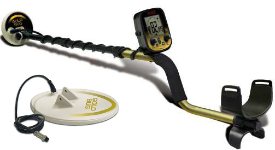 This is the perfect detector and coil combination for prospectors and relic hunters at a special low price. The recently new 5x10 solid DD coil has excellent depth and unbelievable target separation capabilities and has become the go-to coil for many. This coil was designed for the Gold Bug series and it has incredible sensitivity to small targets. It's a real must-have for gold prospectors, and the solid construction makes it great for field stubble. Excellent for coins, relics and jewelry hunting and the standard 6.5 foot cord has shallow water hunters cleaning up. Here's what you can expect from the Gold Bug Pro Metal Detector Coil Combo:
Friday, July 13 2012
It's summer, and that probably means you'll be vacationing or playing near water this month. Whether you're heading to a local lake or to an ocean across the country, take your metal detector. Beach hunting is fun and easy, and usually the finds are, well, pretty fine! Recovering an object from sand is pretty easy, too, especially compared to digging in hard ground. A sand scoop makes target recovery fast and easy.
Water and sunscreen have a sneaky way of slipping rings from fingers of swimmers and sunbathers, making beaches a lucrative location for metal detecting. Necklaces, watches, and bracelets are also great finds on beaches, along with coins— lots of coins. Although some beaches can yield historic artifacts, most finds will likely be of the modern variety. Some detectorists will argue that the best time to find goodies on a beach is after winter storms. While that’s certainly true, summer crowds can mean a fresh crop of coinage and jewelry just waiting to be found by you. Beach hunting can be done in dry sand or out in the water where many more rings are lost. Salt water beaches present special problems (mineralization) and you must determine if you will hunt only in dry sand, dip the coil under water in the shallows, or desire a totally submersible metal detector suitable for deep water wading or diving. All quality metal detectors have submersible search coils but not all control boxes are waterproof or suitable for the pressures of deep water diving, so match your detector to the type of detecting you’ll do. In all types of beach hunting, the discrimination must be kept very low, eliminating only small iron (bobby pins and nails). Aluminum pull tabs and tin foil should not be discriminated or gold and/or platinum rings may not be detected. Some beach hunters operate with zero discrimination and dig everything. Article continued here... Sunday, June 24 2012
The words "concentric" and "DD" (or "double-D") refer to the type of your metal detector's internal coil construction. Most searchcoils (whether round or elliptical) are of concentric construction. A concentric searchcoil has a large transmitter coil, and a smaller receiver coil in the center, usually in the same plane. This coil arrangement is relatively easy to manufacture and its symmetry helps to minimize electrical drift due to time and temperature. It also provides good discrimination on shallow targets.
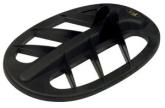 Some searchcoils (whether round or elliptical) are of DD construction. Double-D's comprise two overlapping D-shaped coils of approximately the same size, one being the transmitter and the other the receiver. The advantages of the DD are greater depth in mineralized soil, a broad sweep pattern, and narrower target response. Its primary disadvantages from a user's point of view are multiple responses on shallow targets and poor discrimination of flat iron objects. Designing and manufacturing them is more difficult because their lack of radial symmetry makes them prone to drift which the design and the manufacturing process must minimize. Manufacturing cost is higher because the coils cannot be wound on high-speed winding equipment. Some searchcoils (whether round or elliptical) are of DD construction. Double-D's comprise two overlapping D-shaped coils of approximately the same size, one being the transmitter and the other the receiver. The advantages of the DD are greater depth in mineralized soil, a broad sweep pattern, and narrower target response. Its primary disadvantages from a user's point of view are multiple responses on shallow targets and poor discrimination of flat iron objects. Designing and manufacturing them is more difficult because their lack of radial symmetry makes them prone to drift which the design and the manufacturing process must minimize. Manufacturing cost is higher because the coils cannot be wound on high-speed winding equipment.Double-D's are usually preferred for relic hunting and gold prospecting. Concentrics are usually preferred when searching for modern coins in an area where there is also iron and aluminum trash. Read more about searchcoils here... Monday, April 02 2012
Placer gold is any gold that has been freed from solid rock by weathering. There are several types of placer gold, including Eluvial (gold that has been pulled down hill through the force of gravity), Alluvial (running water has deposited the gold in streams and rivers), and Beach (gold is concentrated by wave action). Eolian placers form by wind action in arid regions. Material broken from the bedrock disintegrates and the winds carry away the surface sand and dust, leaving behind a layer of cement-like mixtures of quartz, schist, and other material. Gold, being heavy, settles in this sun-baked "pavement." For the most part, eolian placer gold can be found just about anywhere in a desert landscape. Look for obvious signs of wind erosion and soil depletion, or a flat area on a wind-blown hillside where vegetation grows. If seeds were trapped in a depression, perhaps gold was, too. Desert miners have learned from experience that since wind has carried away most of the lighter sand and topsoil, eolian gold is usually very close to the surface or even on the surface. You can sometimes spot shiny flakes and tiny pickers practically laying on top of the ground, or a metal detector will find anything that is hidden just below the surface.
Tuesday, January 03 2012
Whether you've been detecting for years or are considering the purchase of your first detector, you want to be as comfortable as possible, for as long as possible, when you're out in the field swinging. No matter the brand or model you are using, detector ergonomics comes down to three things: how your hand grips the detector, the weight and balance of the detector, and the ability to adjust the handle length. A machine with excellent ergonomic design means less strain on your wrist, arm, shoulder, and back.
• There are two types of handle designs used by detector manufactures: the “L” shaped handle and “S” shape. Most detectorists find that the “L” shaped handle helps to reduce the load on the wrist when you swing the search coil. In contrast, gripping the “S” shaped handle tips your hand slightly downward. This slight downward tilt of the hand could put an unnatural strain on your wrist and forearm, and over time could extend to your shoulder. It's really a matter of personal preference and comfort, so just be aware of the two handle designs and which might work the best for you. • The second ergonomic issue is the weight of the detector and how the weight is distributed on the detector’s handle when batteries are in place. A well balanced detector will have equal weight before and after the grip, which is the best possible situation for swinging the search coil for a long period of time. For the “L” shaped handle, the electronics are placed directly above the hand grip, and usually the batteries are placed under the forearm for added balance to the overall assembly. This brings the balance point very close to the hand grip, but still slightly forward of the grip point, which is ideal. • The ability to adjust the lower handle to the correct length for good upright posture while swinging the search coil cannot be over-emphasized. This adjustment will reduce strain on your shoulder and back. Improper adjustment can cause you to bend over while swinging the coil and may result in lower back pain. Ouch! Other ergonomic issues to consider for maximum comfort and enjoyment while detecting is the audio controls. The audio output should be stereo and the volume control should cover a wide range so when you hear a signal, you can discern what the target is made of. Also, if your detector has an LCD display, the display information should be large and readable, even in bright sunlight. Several top metal detector manufacturers such as Garrett, Fisher and Tesoro have perfected the modern art of metal detecting. With each new machine that comes to market, the features and success rate just keeps getting better. Learn more about metal detecting here. Tuesday, July 19 2011
In response to customer requests, AT Pro metal detectors being manufactured by Garrett now feature an upgraded stem configuration. This new upper stem configuration moves the AT Pro’s armrest farther back on the user’s forearm and also includes a new middle stem with camlock fasteners, adding extra stability to the detector during use.
If you purchased your AT Pro detector BEFORE JULY 1, 2011, you may ship your detector back to the Garrett factory in Garland, Texas to get the AT Pro Optional Upgrade / New Warranty Package for only $39.95. This AT Pro Optional Upgrade / New Warranty Program is available for any AT Pro received at Garrett’s Garland factory before December 31, 2011. Here's how it works: • Send your AT Pro detector to the Garrett factory with a check or money order for $39.95, or you can pay via a credit card upon receipt of the detector at Garrett. • New upper stem with extended armrest will be added. • New middle stem with camlock fasteners will be added. • All AT Pro components (searchcoil, electronics, fasteners, etc.) will be inspected and, if necessary, repaired or replaced. • Revised AT Pro detector is shipped from Garrett back to you at Garrett’s expense (you pay for original shipment to Garrett). • Once this preventative maintenance / upgrade work is completed, your AT Pro metal detector will include a new 2-year warranty, effective from the date the unit is shipped back to you (new 2-year warranty replaces any existing Garrett warranty.) The value of the upgrade, preventative maintenance work, replacement parts, and extended warranty is $79.95, however you pay a fixed price of only $39.95! This offer is available directly from Garrett, and not from Garrett metal detector dealers. For more information, call Garrett toll free 800-527-4011 or visit their website www.Garrett.com Wednesday, June 01 2011
Beachcombing with Your Metal Detector
From dry sand to deep salt water, match your detector to the conditions
Wednesday, April 27 2011
Friday, November 26 2010
If you've got a treasure hunter, gold prospector, or outdoorsman on your gift list this season, or are your own not-so-secret Santa, you'll be glad to know about these holiday savings:
• Spend $250 and get a FREE $10 Amazon gift card when you enter the word AMAZON in the Extra Information field at check out (gift card sent separate from your order). *Hurry—offer ends November 30. • Spend $350 and automatically get FREE shipping! No coupon code required. • While supplies last, Fisher is giving away FREE headphones and pick with the purchase of a Gold Bug Pro with 5 inch coil or Gold Bug DP with 11 inch DD coil, or Teknetics G2 metal detector. No coupon code required. • And remember, we have the best prices on Woodman's Pal machete— made in the USA since 1941! We appreciate your business! Hope you had a Happy Thanksgiving! Wednesday, May 19 2010
Metal detecting is one of the easiest, most profitable, and fun ways to find gold and other metallic treasures such as coins, jewelery, and relics. It's so easy to have your metal detector ready to go in its carry bag with extra coils, a digger or scoop, headphones, and spare batteries. Just grab and go! What is the best metal detector? This is probably the #1 question that everyone asks. Unfortunately, there is no "right" answer. The easiest way to find the "best" metal detector for YOU is to evaluate YOUR detecting style, YOUR experience level, what items you hope to find, and the time that you will spend metal detecting. After taking all of these things into consideration, then you will be able to find a metal detector that fits your needs and your budget. You can browse a wide selection of metal detectors, coils, headphones, diggers, scoops, and other accessories from Bounty Hunter, Garrett, Teknetics T2, Tesoro, and Fisher on this site. With the price of gold skyrocketing these days, if you want a special gold detector, you have that choice, too. FREE shipping on any detector priced $350 or more! Have fun and good luck! Wednesday, April 21 2010
Last year, more than 285 million people visited national parks and other units of the National Park System, marking 2009 the fifth busiest year ever. For those who like statistics, that means 10 million more Americans and foreign tourists visited national parks than the year before— a 3.9% increase. The all-time visitation record of 287.2 million was set in 1987. In 2010, the National Park Service is once again offering fee-free days, allowing visitors to check out the nation’s 392 national parks without paying an admission fee that usually ranges from $3 to $25, depending on the park. The fee waiver includes entrance fees, commercial tour fees, and transportation entrance fees. Other costs such as reservations, camping, concessions, and fees collected by third parties are not waived. The first fee-free period this year is actually an entire week—National Parks Week, April 17-25. Although you cannot use your metal detector in a national park, take your detector along on your trip because there are plenty of public lands, parks, etc. to explore while you're traveling. The Top 10 most visited national parks are:
Sunday, January 24 2010
Your chances of finding gold in the desert are about as good as finding gold in wet areas. Study the geology and history of the area where you're prospecting or detecting, and you'll have a distinct advantage. Many large-scale mining operations of yesteryear didn't set up in the desert simply because their equipment needed lots of water, and the desert was much more inaccessible a hundred or more years ago. They didn't have portable Gold Buddy drywashers or variety of spiral gold panning machines that operate on just 3 gallons of water like we do now. So that means less competition! Just like in the mountains during spring snowmelt, one big rainstorm in the desert can change the landscape forever and uncover gold that had been hidden for centuries. Perhaps one of the best locations to look for gold is where the hills meet the desert and fan out. This is where the water slows down during storms and drops gold in the gullies. There also are likely to be more gold traps further up the hillside. Concentrate much of your effort in drywashes, dry streambeds, and canyons. When water flows during a flash flood, areas where the greatest amount of erosion has taken place are natural areas for gold collection. In some areas, like Quartzsite, Arizona, nuggets can be found with a metal detector just under the ground's surface, or even on top of the ground. If you find one piece of gold on the surface of a dry placer area, it is likely that there are more pieces of gold in the immediate area because gold generally does not travel alone. So don't call it quits after the first find— keep looking! Tuesday, October 13 2009
Ancient documents indicate that over 2,000 years ago, a Chinese emperor developed a metal detecting device using magnets. The purpose of his invention was to find weapons before they were used to assassinate him! In the early 20th century in America, metal detectors were developed to monitor metal tools and products in manufacturing plants, primarily to prevent theft. During WWII, more advanced equipment was developed to aid in locating land mines. In 1945, these mine detectors, along with countless other war surplus items, showed up in the marketplace at a fraction of their cost. Veterans familiar with the mine detectors were quick to realize that this equipment could also locate buried treasure... and a new hobby was born! Just one more reason to thank a Vet for his/her service! Today, several companies such as Garrett and Fisher and Bounty Hunter and others have perfected the modern art of metal detecting and the machines just keep getting better. Wednesday, October 07 2009
Purist beach detectorists will argue that the best time to find goodies on a beach is after winter storms. While that’s certainly true, any time after a crowd has been through (Mondays following busy weekends or the day after a holiday), can mean a fresh crop of coins and jewelry just waiting to be found by your metal detector. Although some beaches can yield historic artifacts, most finds will likley be of the modern variety. Thursday, September 03 2009
Although the kids are heading back to school soon, summer is not over yet! Plenty of nice weather for enjoying the great outdoors. If you didn't get to camp as much as you would have liked, plan a short trip this month. Campgrounds and wilderness areas will be less crowded, making for a quieter and probably more pleasant experience. As you pack the gear, don't forget your metal detector! Although searching around campfire rings will most likely reveal trash, searching near picnic tables, restrooms, and play areas could produce a real find. Someone must have spilled their purse near a BBQ grill at a local campground because my detector uncovered not one, not two, but at least a dozen quarters and other assorted change in the sand at the base of the grill! What a pleasant surprise while waiting for the burgers to cook! Happy Labor Day!
|
|
Nugget of News Blog |






 used in as well as the targets being sought. A change in any one of these variables may require a different searchcoil. Sometimes changing the search coil on your metal detector is the next best thing to buying a whole new machine! It is possible that merely changing the coil on your detector will lead you to a host of new targets.
used in as well as the targets being sought. A change in any one of these variables may require a different searchcoil. Sometimes changing the search coil on your metal detector is the next best thing to buying a whole new machine! It is possible that merely changing the coil on your detector will lead you to a host of new targets. significantly reduce ground interference and, thereby, recover the performance lost by a concentric coil over mineralized soil. With the Double-D, it is the arrangement of the TX and RX coils that produce a canceling effect of ground signals. This configuration is called DD because both TX and RX coils are in the shape of a “D”. The positive detection fi eld of the DD runs beneath the overlapping center section from front-to-back. The remaining portion of the coil actually produces negative (i.e. canceling) detection fields. It is this canceling field that allows the DD coil to maintain performance over mineralized ground. Because of its small positive detection field, the DD is inherently less sensitive than a concentric searchcoil of the same size, over non-mineralized ground. The Double-D will, however, significantly outperform the concentric coil over mineralized ground. For this reason, it is highly recommended when hunting over mineralized ground commonly found when prospecting and relic hunting.
significantly reduce ground interference and, thereby, recover the performance lost by a concentric coil over mineralized soil. With the Double-D, it is the arrangement of the TX and RX coils that produce a canceling effect of ground signals. This configuration is called DD because both TX and RX coils are in the shape of a “D”. The positive detection fi eld of the DD runs beneath the overlapping center section from front-to-back. The remaining portion of the coil actually produces negative (i.e. canceling) detection fields. It is this canceling field that allows the DD coil to maintain performance over mineralized ground. Because of its small positive detection field, the DD is inherently less sensitive than a concentric searchcoil of the same size, over non-mineralized ground. The Double-D will, however, significantly outperform the concentric coil over mineralized ground. For this reason, it is highly recommended when hunting over mineralized ground commonly found when prospecting and relic hunting.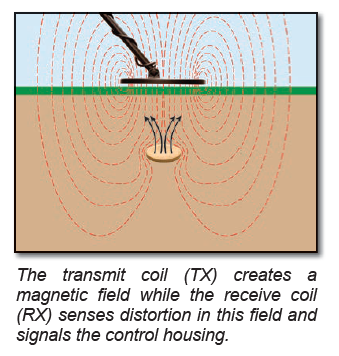
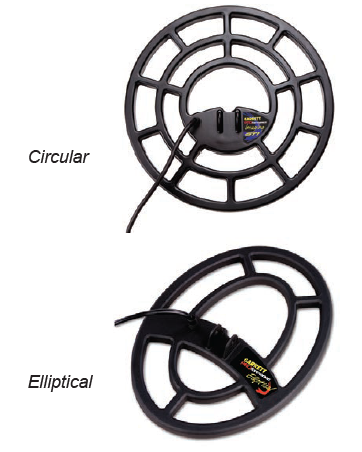
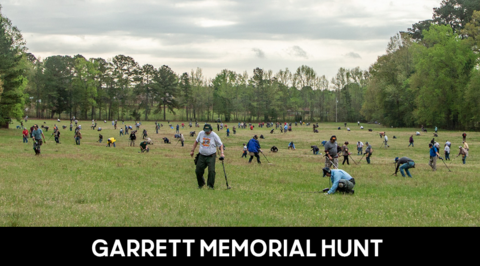
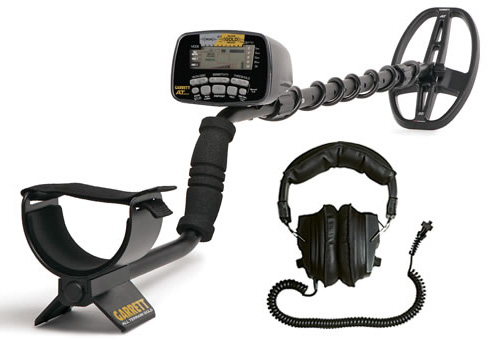

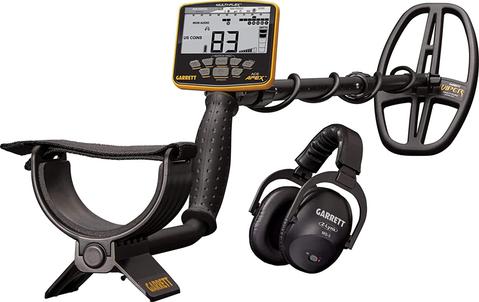
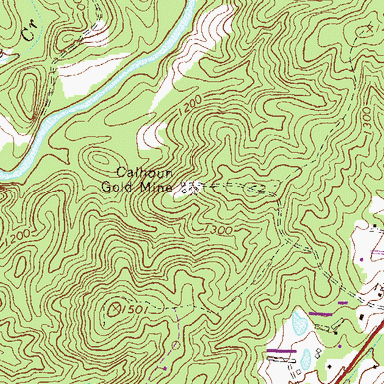
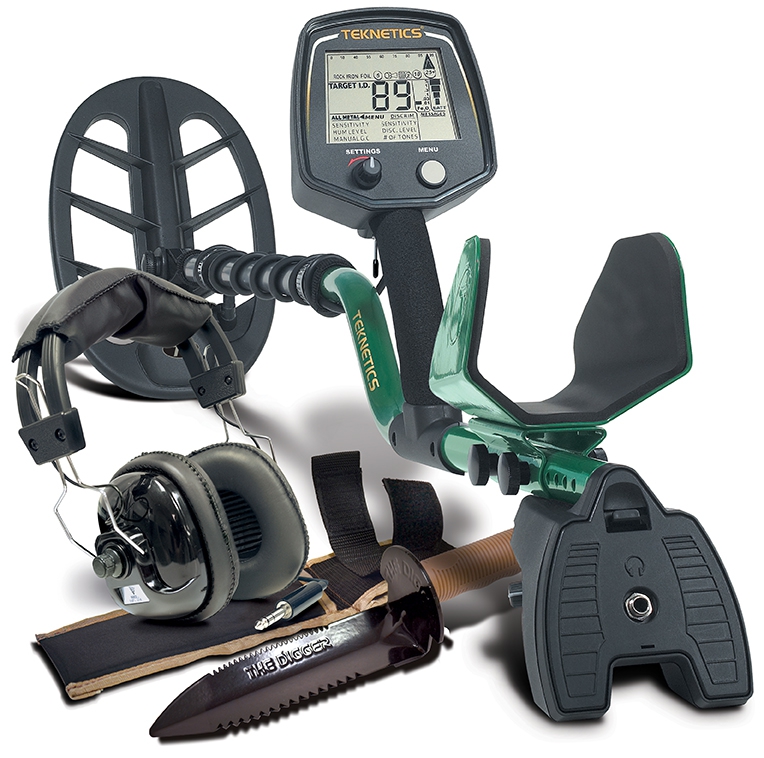
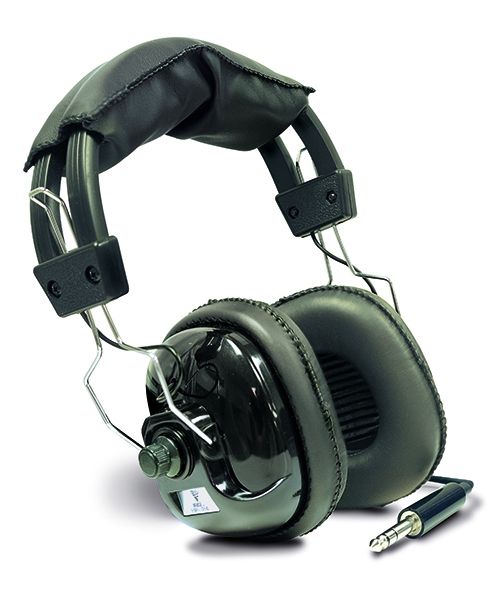
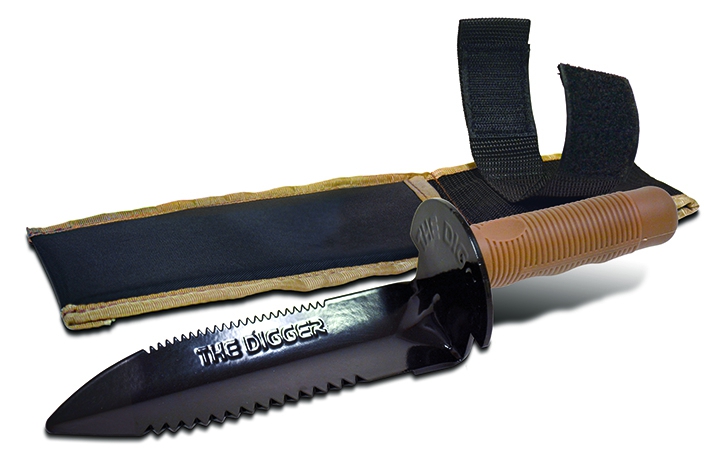
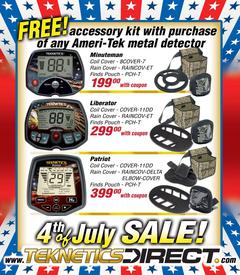 treasure finding machines from Teknetics with true blue American graphics on their faceplates. Proudly made in the USA by Fisher Labs, these units are making award-winning metal detectors affordable again! Whether you're looking for the ease of a turn-on-and-go coin shooter or want more features for gold prospecting, you will find it in the affordable Ameritek line. All three detectors feature waterproof searchcoils, large two-digit numeric displays, and are perfectly balanced and light-weight so you can swing all day. Click the links below to check out the features of each new machine and
treasure finding machines from Teknetics with true blue American graphics on their faceplates. Proudly made in the USA by Fisher Labs, these units are making award-winning metal detectors affordable again! Whether you're looking for the ease of a turn-on-and-go coin shooter or want more features for gold prospecting, you will find it in the affordable Ameritek line. All three detectors feature waterproof searchcoils, large two-digit numeric displays, and are perfectly balanced and light-weight so you can swing all day. Click the links below to check out the features of each new machine and 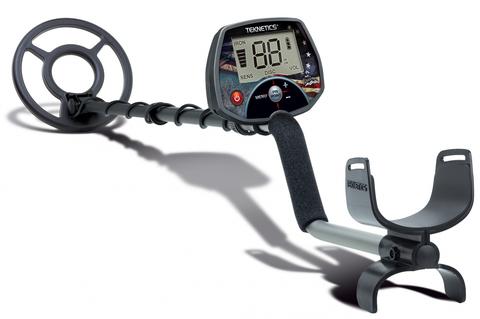
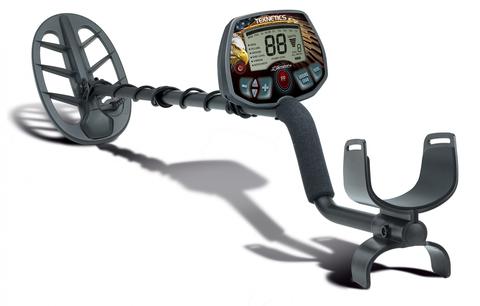
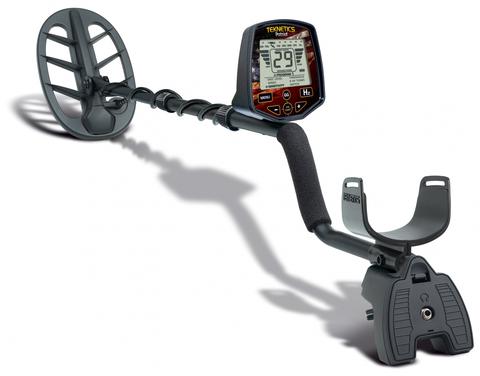
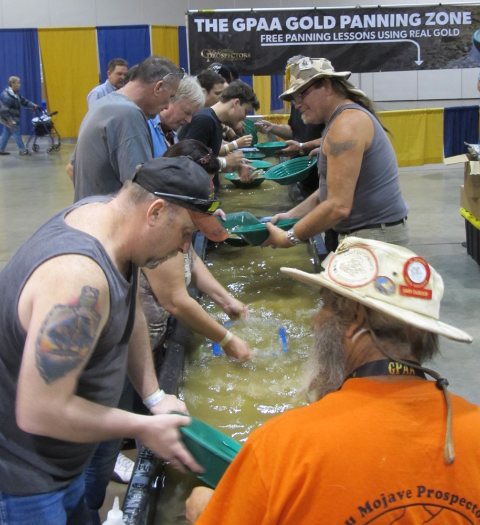


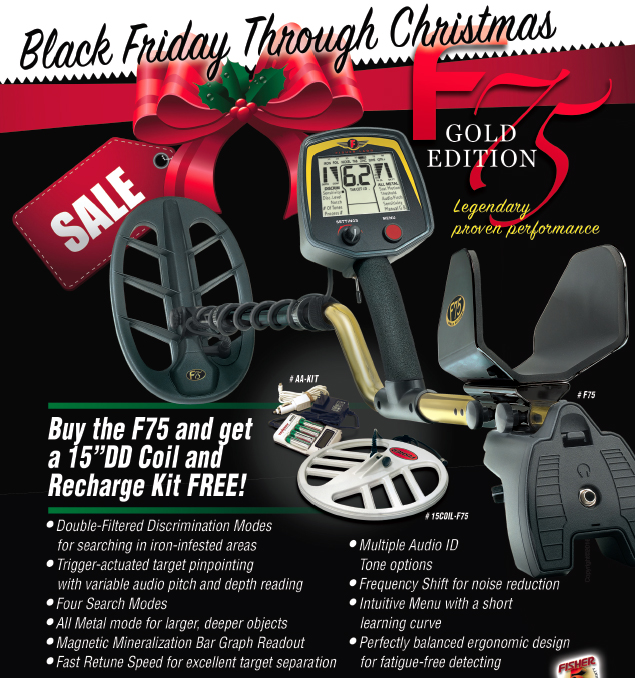
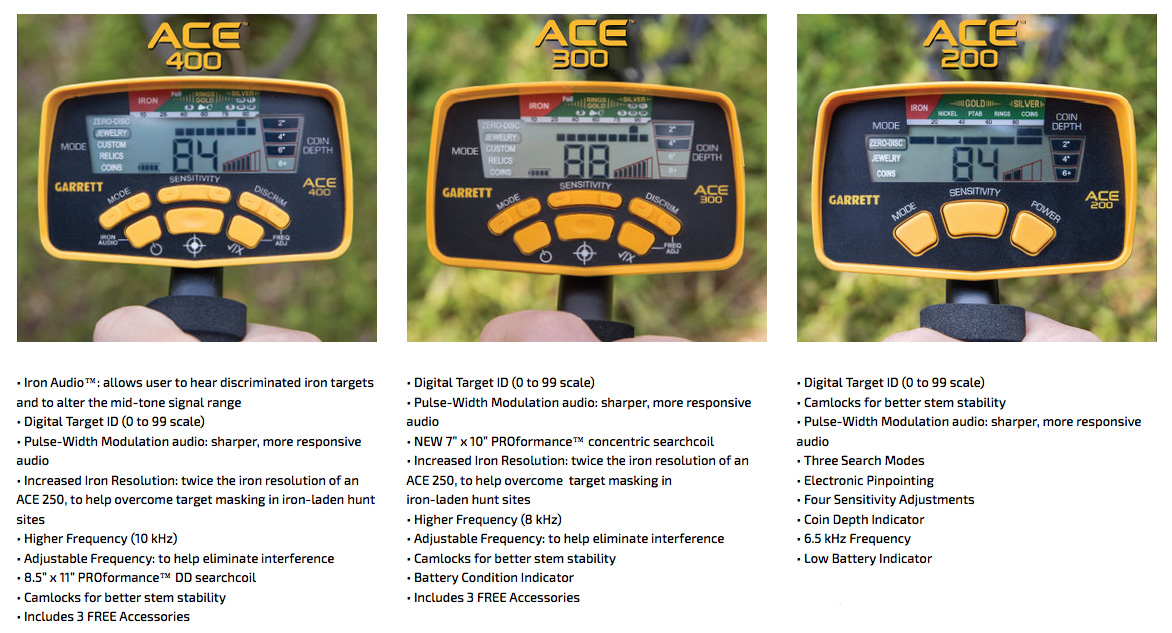

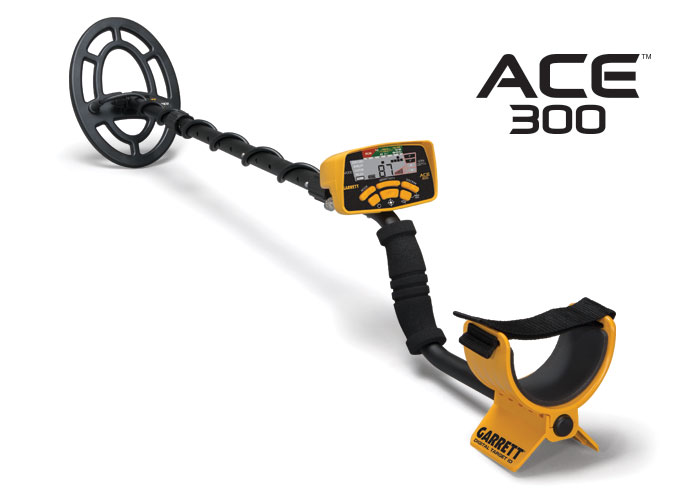
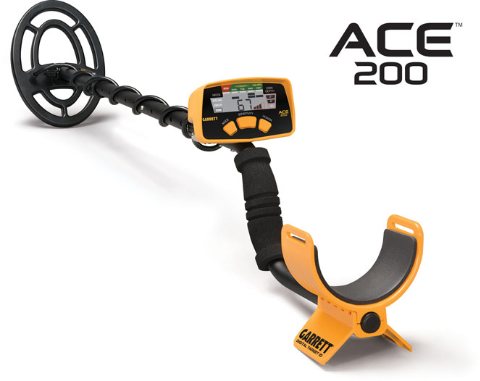

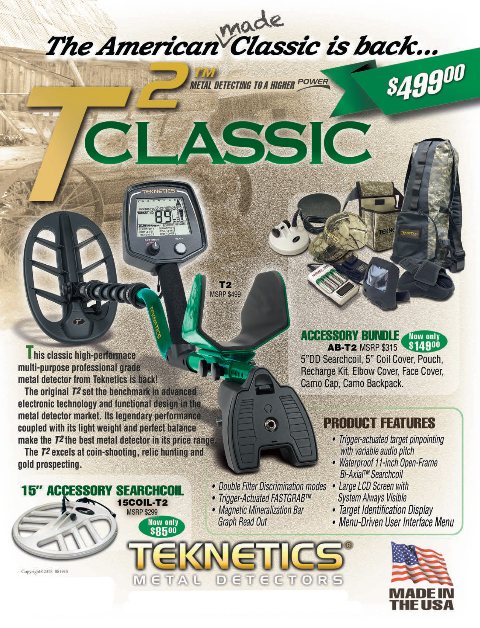
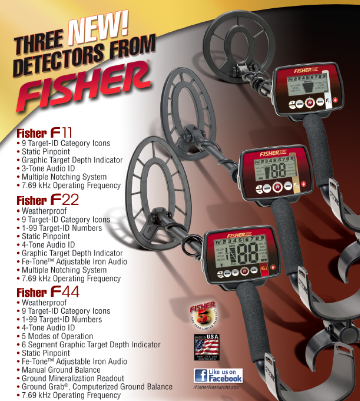
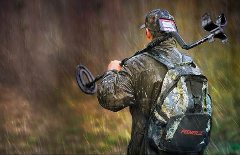 The Fisher F44 weatherproof metal detector is backlit and environmentally sealed for use in the toughest environments. This unit comes with an 11 inch Concentric Elliptical Waterproof Searchcoil and is ideal for inclement weather hunting, beach hunting, coin shooting, jewelry hunting, and relic hunting. For only $349 you get many, many features that are usually only found on higher priced models— 9-Segment Visual Target-ID, 5 Modes of Operation, 20 Levels of Adjustable Sensitivity, 20 Levels of Adjustable Volume, 4-Tone Audio-ID and MORE!
The Fisher F44 weatherproof metal detector is backlit and environmentally sealed for use in the toughest environments. This unit comes with an 11 inch Concentric Elliptical Waterproof Searchcoil and is ideal for inclement weather hunting, beach hunting, coin shooting, jewelry hunting, and relic hunting. For only $349 you get many, many features that are usually only found on higher priced models— 9-Segment Visual Target-ID, 5 Modes of Operation, 20 Levels of Adjustable Sensitivity, 20 Levels of Adjustable Volume, 4-Tone Audio-ID and MORE! 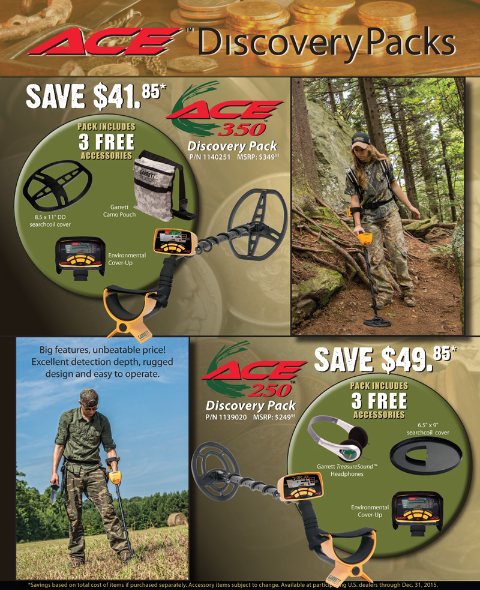
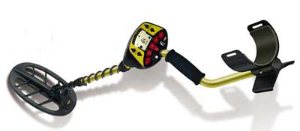
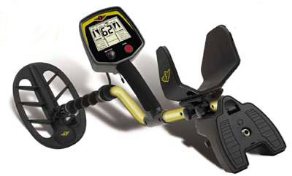
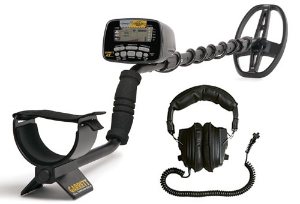
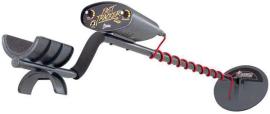
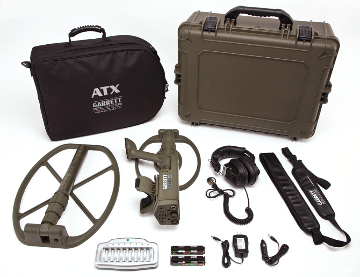
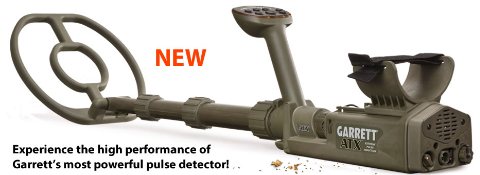 my wrist, which gave it a perfect fit and feel, and allowed me to work all of the control buttons easily with my thumb. I pushed the unit out in front of me a bit and turned on the power switch, which is located on the back of the unit. The Garrett ATX Deepseeker Metal Detector goes through its startup and self-diagnostic test. Every light on the control pad comes on and unit emits several different sounds before settling into a comfortable, but high, threshold. This is not a turn-on-and-go detector. Either read the entire owners manual before you go out hunting, or at least read the first two pages of the manual— page 1 is the Quick Start Guide and an explanation of how to access the functions of the ATX quickly, and page 2 shows you where to find more information concerning those functions.
my wrist, which gave it a perfect fit and feel, and allowed me to work all of the control buttons easily with my thumb. I pushed the unit out in front of me a bit and turned on the power switch, which is located on the back of the unit. The Garrett ATX Deepseeker Metal Detector goes through its startup and self-diagnostic test. Every light on the control pad comes on and unit emits several different sounds before settling into a comfortable, but high, threshold. This is not a turn-on-and-go detector. Either read the entire owners manual before you go out hunting, or at least read the first two pages of the manual— page 1 is the Quick Start Guide and an explanation of how to access the functions of the ATX quickly, and page 2 shows you where to find more information concerning those functions. There are 5 major functions that are completely user-adjustable: Mode, Sensitivity, Threshold, Volume, and Ground Balance. Are functions are easy to adjust with a basic understanding of the ATX and more tunable as you become more proficient. Secondary functions include iron check, tracking, discrimmination and frequency shifting, to name only a few.
There are 5 major functions that are completely user-adjustable: Mode, Sensitivity, Threshold, Volume, and Ground Balance. Are functions are easy to adjust with a basic understanding of the ATX and more tunable as you become more proficient. Secondary functions include iron check, tracking, discrimmination and frequency shifting, to name only a few.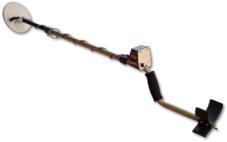

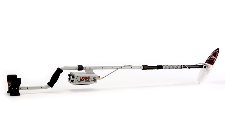 • Do you have gold fever? The Lobo Super TRAQ is an incredibly versatile, feature-rich machine that triumphs in small gold nugget prospecting. Spoil yourself with a detector that self-adjusts to any type of soil, even in highly mineralized locations. While the Lobo is designed to find gold, it also thrives in detecting coins, relics, and other treasures, too. A great value for only $679.15!
• Do you have gold fever? The Lobo Super TRAQ is an incredibly versatile, feature-rich machine that triumphs in small gold nugget prospecting. Spoil yourself with a detector that self-adjusts to any type of soil, even in highly mineralized locations. While the Lobo is designed to find gold, it also thrives in detecting coins, relics, and other treasures, too. A great value for only $679.15!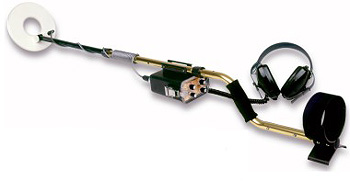

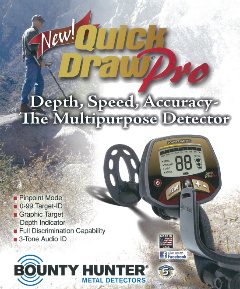
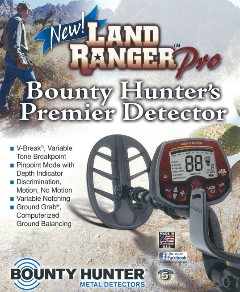
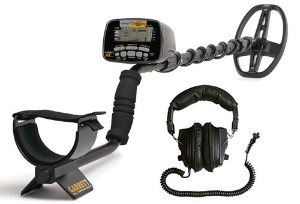 If you prefer a finer degree of control, manual ground balancing is achieved by raising and lowering the detector coil a few inches over the ground. The detector will sound off either as the coil approaches the ground or as it is raised away form the ground. The ground balance control is manipulated until there is no sound either raising or lowering the coil. The detector is now said to be ground balanced. (Always read your detector's Owners Manual, too, for instructions.)
If you prefer a finer degree of control, manual ground balancing is achieved by raising and lowering the detector coil a few inches over the ground. The detector will sound off either as the coil approaches the ground or as it is raised away form the ground. The ground balance control is manipulated until there is no sound either raising or lowering the coil. The detector is now said to be ground balanced. (Always read your detector's Owners Manual, too, for instructions.)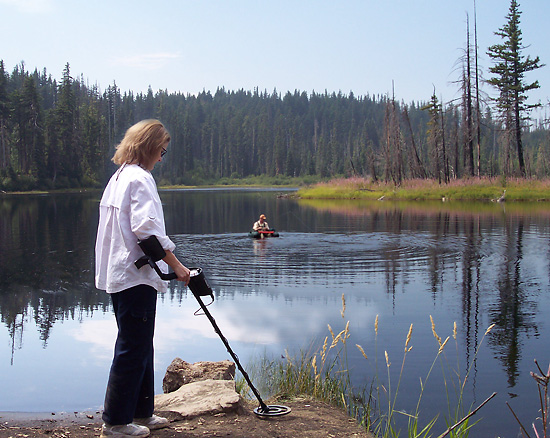 If you carry a cell phone or other high-tech gadget with you out in the field, try turning it off (all the way off -- not just airport mode) and see if that solves the problem. When hunting near overhead power lines, you may get the best results right under the lines; the worst results occur about a 30 to 45 degree angle away. Many sources of interference are intermittent, so through trial and error you might find that a particular time of day or day of the week is makes it more or less difficult to detect. Power lines are usually quietest late at night and on early weekend mornings.
If you carry a cell phone or other high-tech gadget with you out in the field, try turning it off (all the way off -- not just airport mode) and see if that solves the problem. When hunting near overhead power lines, you may get the best results right under the lines; the worst results occur about a 30 to 45 degree angle away. Many sources of interference are intermittent, so through trial and error you might find that a particular time of day or day of the week is makes it more or less difficult to detect. Power lines are usually quietest late at night and on early weekend mornings.
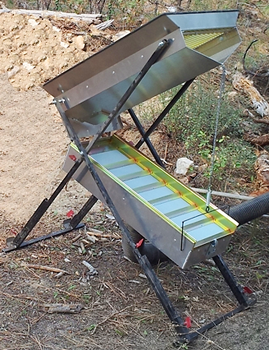 Drywashers are operated by shoveling gold-bearing gravels into an upper box which is covered with a screen. The larger rocks that are too big to pass through the screen slide off. Gravel small enough to go through is fed down into the lower gold recovery box, which is an inclined trough with cross riffles much like a sluice. The bottom of the recovery box consists of a thin, light-weight porous cloth. Beneath the riffle box is a blower that pulses air up through the cloth. The vibrations and air flow, combined with the shaking and classifying action of the dry washer allows the gold to settle to the bottom where it is captured in the riffles.
Drywashers are operated by shoveling gold-bearing gravels into an upper box which is covered with a screen. The larger rocks that are too big to pass through the screen slide off. Gravel small enough to go through is fed down into the lower gold recovery box, which is an inclined trough with cross riffles much like a sluice. The bottom of the recovery box consists of a thin, light-weight porous cloth. Beneath the riffle box is a blower that pulses air up through the cloth. The vibrations and air flow, combined with the shaking and classifying action of the dry washer allows the gold to settle to the bottom where it is captured in the riffles.